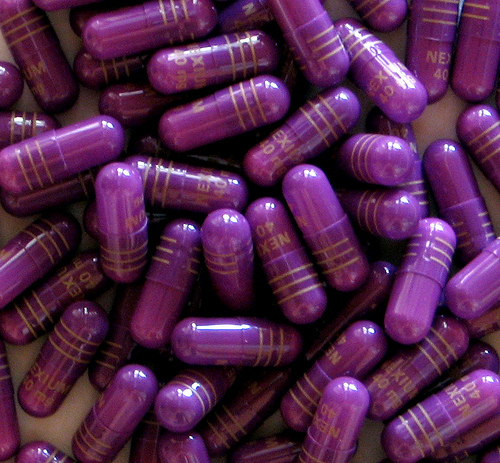 We know that PPIs are better than H2RAs at raising intragastric pH, but we don’t know whether this higher pH value translates to superior clinical outcomes. In fact, there is some debate whether a higher pH could actually cause problems, like nosocomial pneumonia or Clostridium difficile infection. Given that clinically important GI bleeding has been associated with a high mortality rate (48.5% vs. 9.1% in non-bleeders), it seems that selecting the best agent for stress ulcer prophylaxis is an important decision.
This hotly-debated topic, reinvigorated by the 2012 Surviving Sepsis Campaign Guidelines’ grade 2D recommendation in favor of PPIs, has again been examined with a recent meta-analysis by Alhazzani et al published in the March 2013 issue of Critical Care Medicine.
We know that PPIs are better than H2RAs at raising intragastric pH, but we don’t know whether this higher pH value translates to superior clinical outcomes. In fact, there is some debate whether a higher pH could actually cause problems, like nosocomial pneumonia or Clostridium difficile infection. Given that clinically important GI bleeding has been associated with a high mortality rate (48.5% vs. 9.1% in non-bleeders), it seems that selecting the best agent for stress ulcer prophylaxis is an important decision.
This hotly-debated topic, reinvigorated by the 2012 Surviving Sepsis Campaign Guidelines’ grade 2D recommendation in favor of PPIs, has again been examined with a recent meta-analysis by Alhazzani et al published in the March 2013 issue of Critical Care Medicine.
Actual .pdf of meta-analysis.
Of course, this is not the first meta-analysis to examine the topic. In fact, three other meta-analyses have been published since 2009. Here, here, and here. Naturally, the authors of this most recent meta-analysis claim that their statistical analysis was superior, they included more relevant trials, and they excluded more inappropriate trials to make this analysis a more pure, scientifically-valid view of the data.
This meta-analysis combined 14 randomized controlled trials with 1,720 total patients. The analysis concluded that PPIs were associated with a reduction in clinically important upper GI bleeding (1.2% vs. 6.4%, NNT 19, RR 0.36, p=0.002) and overt upper GI bleeding (3.8% vs. 15.7%, NNT 9, RR 0.35, p<0.0001). There was no difference in nosocomial pneumonia, ICU mortality, or ICU length of stay.
Is it time for famotidine and ranitidine to hang up their hat in the ICU? The evidence from this meta-analysis appears compelling at first glance, but diving deep into the manuscript reveals some troubling issues.
First, the included trials were not comparing similar treatments of H2RAs. Some trials used continuous infusions, some used once daily dosing, and one did not report dose at all. It is scientifically questionable to pool a variety of different H2RAs with different dosing strategies together into a single group and categorize the treatments as being the same.
Second, the included trials did not have consistent definitions for “clinically important bleeding” and “overt bleeding”. Some trials used very strict definitions where bleeding had to be confirmed with EGD, others has very loose criteria (eg, hemodynamic instability not explained by other causes), and some did not even provide definitions. Indicative of the questionable criteria, 5 of the 12 included trials had an event rate of 0% in both arms, whereas one trial had an event rate as high as 31%.
Third, one must question whether the endpoint of “clinically important bleeding” is a surrogate or a clinically relevant outcome. Given the questionable definitions and criteria used, a firm endpoint like ICU mortality would be a definitive approach to concluding a victor. Unfortunately, there was no difference in ICU mortality demonstrated in this meta-analysis (17.5% PPI vs. 21.2% H2RA, p=0.91).
Given the paucity of high-quality data examining PPIs versus H2RAs for stress ulcer prophylaxis, it can be extremely temping to favor meta-analyses to find an answer to this compelling question. The fallacy in this approach, however, is that you cannot take a multitude of poor-quality trials (many with fewer than 50 patients in the H2RA arm) and somehow combine the data into a valid, reliable, unbiased manuscript on which you base your clinical practice.
So how should we interpret this meta-analysis? In my view, until better quality evidence comes out, there is no proven difference in the prevention of stress ulcer prophylaxis between PPIs and H2RAs. The decision should be made based on formulary considerations (cost and availability), formulation considerations (ability to be crushed), the patient’s history of using a particular agent prior to admission, and potentially drug interactions (although I believe the PPI/omeprazole debate has not been concluded).
 Sean P. Kane is a critical care clinical pharmacist and the author of ClinCalc.com -- an evidence-based website with clinical tools and calculators for medical professionals.
Sean P. Kane is a critical care clinical pharmacist and the author of ClinCalc.com -- an evidence-based website with clinical tools and calculators for medical professionals.
Nexium photo: Photo credit: License Some rights reserved by Rennett Stowe
Some rights reserved by Rennett Stowe



